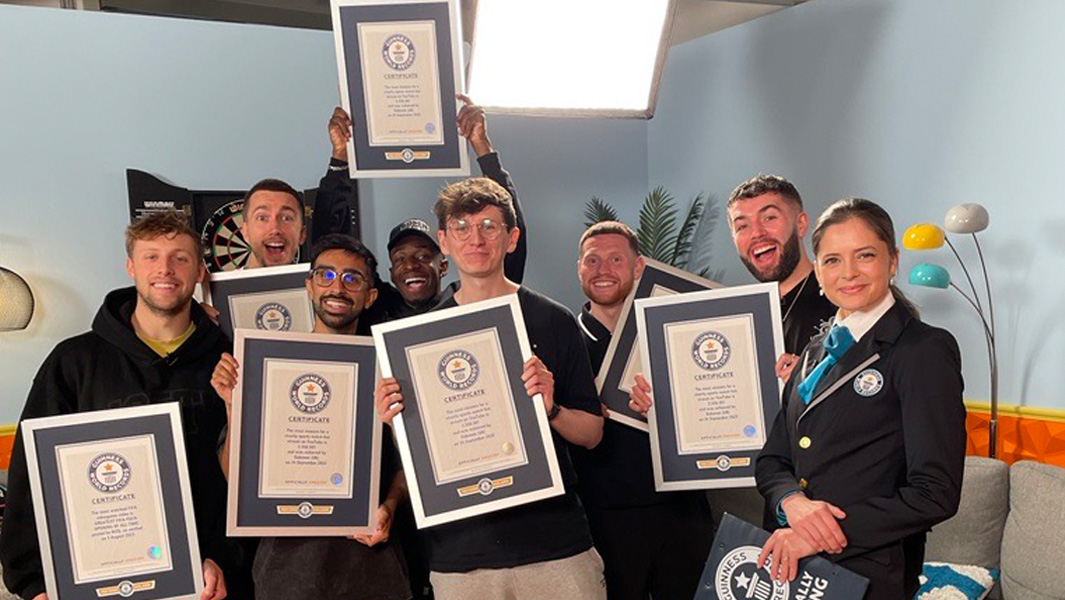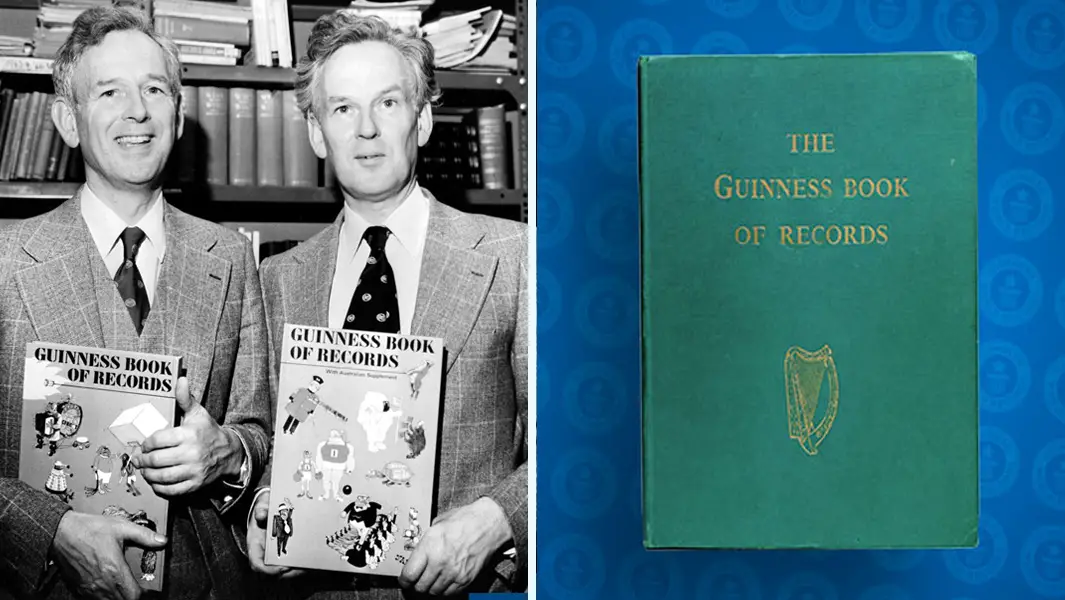


The year is 1955 and, for the first time, the newly published Guinness Book of Records hits the bookstores.
Just before Christmas, the fact-packed book topped the charts and became a bestseller in the UK thanks to impressive human beings, wonders of nature, jaw-dropping pictures and marvellous scientific facts.
Ever since, Guinness World Records has built a reputation as the ultimate authority on record breaking.
But do you know how the Guinness Book of Records came to be?
Read on to find out why and how the Guinness Book of Records was first created, later to evolve into the global company that Guinness World Records is today.

On an unknown date in November 1951, Sir Hugh Beaver (1890-1967) was out shooting on Slob Hill, by the river Slaney in County Wexford in the south-east of Ireland. Some golden plovers were missed by the party.
This text appears in the 31st edition of the Guinness Book of Records, published between 1984 and 1985.
The hunting party, which included Managing Director of the Guinness Brewery Sir Hugh Beaver, argued about the fastest game bird in Europe. Some believed it to be the golden plover, who had evaded their guns that day, while others disagreed. After returning home, they found that no existing reference book could either confirm or deny the theory.
It occurred to Sir Hugh that there must have been several other friendly disputes debated nightly in the then "81,400 pubs of Britain and Ireland".
However, there was no book to settle arguments about records.

Therefore the Guinness Book of Records was created and distributed for free in pubs across the country as a promotional asset for the Guinness brand.
But the popularity of the book soon skyrocketed, and the book itself was often stolen from pubs!
Therefore, Sir Hugh decided to assemble the best researches and fact-checkers of the time to create a proper book of records for retail.
It was then that Chris Chataway, the Chelsea-born Olympic runner and an underbrewer at Guinness' Park Royal Brewery, recommended the twins Norris and Ross McWhirter.
On 12 September 1954, Norris and Ross McWhirter, then running a fact finding agency in London, were invited to discuss the proposition that a collection of records should be published.
They so impressed the Guinness Board that they were immediately commissioned to follow it through.
"I remember the date was Tuesday, 14th September, 1954 because it was our father's last birthday," writes Norris McWhirter.

"Like so many things in life the Guinness Book of Records began with a phone call." - Norris McWhirter
To work on a book that would truly become a resource for all (or most) questions that still remained without an answer, several correspondences started with knowledgeable names in all fields.
From astrophysicists to physiologists and zoologists, no stone of wisdom was left unturned.
After the information-gathering phase, the book was written in thirteen-and-a-half 90-hour weeks.
That took in Saturdays, Sundays and Bank Holidays.

So, what bird is actually the fastest game bird?
The red-breasted merganser (Mergus serrator) set the record straight by officially becoming the fastest-flying species of game bird with a maximum recorded level flying speed of 130 km (81 mph).
The first copy of the Guinness Book of Records was completed on 30 June, with a publication date of 3 October 1955.
Counting 198 pages, the book soon populated bookstores all over the country with its deep green cover, golden lettering and the Guinness harp logo.
It was quite a slim edition considering that, today, the average page-count for our annual is 256. Just like its modern version, however, the publication was packed with facts and tables, and even included some pictures.
As playfully stated in a complementary copy distributed to members of Foyles Book Clubs in 1958, it was the birth of "a book to start arguments – and to end them!"
From an ingenious advertising tool to the go-to source for knowledge before the Internet, the fame of the argument-ending book only grew over time.
After that first edition, a new edition has been published every year except for 1957, 1959 and 1963.
The covers changed according to the style of the decade, developing from the minimal, elegant design of the '50s to the colourful collage of pictures in the '60s and '70s.
In 1974, Guinness World Records hit another milestone: the book - still then called Guinness Book of Records - became the biggest-selling copyright book in history.
In 1976, a museum entirely dedicated to Guinness World Records opened in the historic Empire State Building, New York City, USA.
In 1991, another museum opened in Hollywood, Los Angeles.
After the death of his twin brother, Norris McWhirter remained Editor-in-chief until 1986.
That year he passed the baton of editorship to Alan Russell, who would grow to create the BBC Children TV show Record Breakers, running from the '70s to 2001.
Norris continued to work as consultant for GWR until he died in 2004.

Did you know? In 2009, Guinness World Records reversed the clock to 1955.
A limited number of copies of the first, best-selling edition of Guinness World Records was reprinted.
After almost 50 editions and with a well-established name in publishing, Guinness World Records approached the dawn of the 21st Century with enthusiasm.
The new millennium blew winds of change at GWR, starting with a shiny silver foil cover and a new name.
The book was renamed from the Guinness Book of Records to the current title of Guinness World Records.
To kickstart the new decade, Guinness World Records 2000 broke a record and became the largest print run of a case-bound book in colour.
The year after, in 2001, the company passed from Diageo (the owners of Guinness) to the hands of Gullane Entertainment, the British independent production company behind Thomas & Friends, therefore cutting all its previous ties with the brewery.
Even though their pasts will remain forever intertwined, to this day there is no affiliation between Guinness World Records and Guinness Brewery.

In 2004, Her Majesty Queen Elizabeth II visited the Guinness World Records office in London to receive the special 50th anniversary edition.
Led by Editor-in-chief Craig Glenday, who this year celebrates 20 years at GWR, Guinness World Records is now a global authority on record-breaking.
"I've had the most remarkable 20 years working at Guinness World Records," Craig said.
"For a facts and stats nerd like me - who knows very little about a lot of things! - it's a dream job. No two days are ever the same: name another job where you can have breakfast with a moonwalker, lunch with an Oscar winner then spend the night out in the company of chainsaw jugglers and fire-eaters!"
It's a privilege to be the caretaker of these records and get the chance to share them in a book that continues to be a best-seller, inspiring millions of people around the world every year." - Craig Glenday
The book is distributed in more than 100 countries and translated into over 40 languages.
In 2019, the authority on record breaking reported that over 143 million editions of the book had been sold worldwide since 1954.

To this day, our book is a team effort that calls on the expertise of specialists from every imaginable field.
Our consultants allow us to cover efficiently the most complicated topics and historical firsts (such as the first men on the moon, record broken by Neil Armstrong and Edwin E. "Buzz" Aldrin in 1969), providing precise details and unshakeable expertise.
Thanks to the joint efforts of our in-house editorial team and external experts, Guinness World Records has become a source for the curious, for the inquisitive mind, and has answered questions like:
At the moment, over 60,789 active record titles are monitored by Guinness World Records.
"The joy of working here is getting to meet the world's most amazing people," says editor-in-chief Craig Glenday, who is always excited to meet new record holders.
"Literally and officially the world's most amazing athletes, astronauts, actors, singers, jugglers, contortionists, adventurers and scientists, as well as some incredible pets and wild animals, too, of course."
Some titles change hands fast, like modern music records and highest grossing films, some have been discontinued (like the "heaviest cat" category, discontinued in the '90s to prevent owners from overfeeding their pets) while others will likely never be beaten!
Every year we strive to create a more sustainable, inclusive and diverse book.
As a brand we also aim for a minimal environmental impact within our production:
We keep our eyes to the future, to the record breakers of tomorrow and to the many editions to come.
Sometimes, though, it's interesting to look back at our history and remember that, hundreds of thousands of words ago, it all started with a hunting party - and a lucky Golden Plover.

Discover a whole new galaxy of amazing records with Guinness World Records 2023! Out in bookstores and online from 15 September 2022, find your copy today.